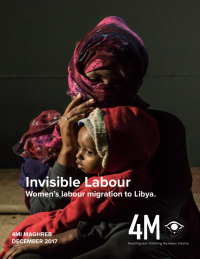reliefweb | 03.01.2017
Introduction
This briefing paper, based on data collected through the Mixed Migration Monitoring Mechanism initiative (4Mi) in Libya from May to December 2017 and additional interviews with migrants and key informants, explores the Libyan work environment for migrant women. The paper aims at providing a better picture of the specific factors that affect the working context and migration trajectories of migrant women in Libya.
Among the scarce literature on women’s migration to Libya, little or no attention is paid to the independent economic motivations behind their journeys or their role in the workforce. While the common narrative on female migration to and through Libya generally portrays women as victims of trafficking and forced migrants to follow their husband or family, data collected by 4Mi shows that women’s role as independent economic actor plays a significant push factor in their migration. Whether motivated to transit Libya or to settle and work there, many women are inclined to seek employment, and independently navigate their status and opportunities in the new country.
Working scenarios for migrants in pre and post-revolution Libya
Despite the recent international focus on mixed migration flows to and through Libya, immigration is part of the Libyan history. From the 1970s to the 1990s, the Government of Gaddafi actively encouraged migration from Arab countries and later from the entire African continent to meet manpower needs in sectors such as agriculture and construction. Immigrants were attracted by the country’s relative wealth and by an open-door policy, which granted them visa-free entry. Several bilateral agreements were negotiated to ease the employment of foreign workers5 and a blind eye was turned on the recruitment of undocumented immigrants.

